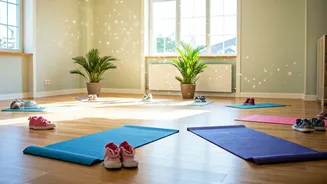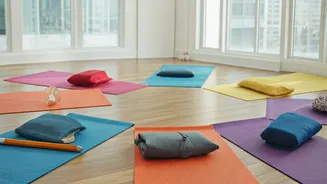Introduction: Yoga's Power
Yoga, an ancient practice, is increasingly recognized for its holistic benefits, extending beyond physical fitness. For children, yoga offers a unique
approach to enhancing both mental and physical health. It provides tools to improve concentration, memory, and emotional regulation. Unlike rigorous exercises, yoga for kids combines playfulness with purposeful movement, creating an engaging experience that supports cognitive development. Regular practice fosters a calmer mind, improves focus, and enhances memory retention, making it a valuable addition to any child's routine. Yoga's accessible nature makes it adaptable for children of various ages and abilities, contributing to overall well-being. By incorporating these poses into your child's day, you're investing in their present and future capabilities, paving the way for improved academic performance and emotional stability.
Mountain Pose (Tadasana)
Tadasana, or Mountain Pose, is an excellent starting point for any yoga session. This foundational pose helps kids develop body awareness and a sense of grounding. To perform this, the child should stand tall with feet together, arms relaxed at their sides. They should engage their core muscles, lengthening their spine and lifting their chest. The key is to imagine a string gently pulling them upwards from the crown of the head. Mountain Pose cultivates a feeling of stability and presence, enhancing focus. It teaches children to be mindful of their posture and breath, which are essential elements for better concentration. Additionally, it helps to calm the mind and prepare them for deeper concentration, making it a perfect pre-activity to begin your kid’s yoga practice.
Tree Pose (Vrksasana)
Vrksasana, or Tree Pose, is a balancing posture that significantly boosts focus and coordination. In this pose, the child should stand on one leg, bringing the sole of the other foot either to the inner thigh or calf of the standing leg, avoiding the knee. Once balanced, they should bring their hands together in a prayer position in front of their chest or extend them upwards like the branches of a tree. Tree Pose demands intense concentration, encouraging the child to fix their gaze on a single point (drishti) to maintain balance. This act of focus not only improves physical balance but also helps strengthen mental clarity and memory. Practicing Tree Pose regularly can enhance proprioception (body awareness) and reduce mind wandering, which is beneficial for both classroom and everyday activities.
Warrior II (Virabhadrasana II)
Warrior II, also known as Virabhadrasana II, incorporates strength and focus. To get into this pose, a child should stand with their feet wide apart, turning one foot out to the side while keeping the back foot slightly angled inward. They should bend the front knee over the ankle, ensuring the knee does not extend past the toes. Arms are extended to the sides, parallel to the ground, with the gaze focused over the front hand. This pose requires children to hold their concentration while building stamina and stability. It teaches them to remain grounded and centered amidst external pressures. The practice strengthens the mind-body connection, improving both physical and mental resilience and enhancing memory and overall concentration.
Triangle Pose (Trikonasana)
Triangle Pose, or Trikonasana, stretches the body while emphasizing balance and focus. To achieve this, the child should stand with their feet apart, turning one foot out and the other slightly inward. They then reach one arm towards the extended foot while the other arm stretches upwards, creating a triangle shape. Maintaining alignment is key, ensuring the body stays in one plane. This pose strengthens the core and opens the chest, promoting a sense of calm. Triangle Pose demands focus to prevent falls, making it excellent for improving concentration. The deep stretches stimulate the brain and increase blood flow, which in turn leads to improved cognitive function and enhanced memory.
Cobra Pose (Bhujangasana)
Bhujangasana, or Cobra Pose, is a gentle backbend that stimulates the mind and helps to alleviate stress. In this pose, the child lies on their stomach with hands under their shoulders. They lift their chest off the floor, engaging their back muscles while keeping the pelvis on the ground. Cobra Pose improves spinal flexibility and invigorates the nervous system. The gentle compression on the abdomen stimulates digestion and can improve overall energy levels. It enhances memory by increasing blood circulation to the brain, improving focus and concentration. This pose also helps to release tension, promoting a relaxed state of mind which is conducive to better learning and memory recall.
Bridge Pose (Setu Bandhasana)
Setu Bandhasana, or Bridge Pose, is a gentle backbend that invigorates the brain and calms the mind. To perform this, the child should lie on their back with knees bent and feet flat on the floor. They then lift their hips off the ground, supporting their weight on their shoulders and feet, and optionally clasping their hands beneath the body. Bridge Pose is excellent for improving memory and concentration by increasing blood flow to the brain, enhancing cognitive function. This pose gently stretches the spine, strengthens the back muscles, and calms the nervous system, thus helping reduce stress. Additionally, it helps with focus and reduces fatigue, making it suitable for children struggling to concentrate or facing memory challenges.
Seated Forward Bend (Paschimottanasana)
Paschimottanasana, or Seated Forward Bend, is a calming pose that soothes the mind and improves memory. The child begins in a seated position with legs extended. They should then reach forward, trying to touch their toes while keeping their spine straight. This pose can also be modified by bending the knees slightly. This pose is particularly effective in calming the mind and reducing anxiety. It improves blood circulation to the brain, which enhances memory and concentration. Furthermore, the forward fold stretches the spine and hamstrings, promoting relaxation and focus. Regularly practicing Seated Forward Bend can enhance memory, helping children stay focused and organized.
Child's Pose (Balasana)
Balasana, or Child's Pose, is a restful posture that offers a sense of calm and helps in stress reduction. The child kneels on the floor, bringing their big toes together and sitting back on their heels. They then lean forward, resting their forehead on the ground and stretching their arms forward or resting them alongside their body. This pose is great for calming the mind and reducing stress, creating a perfect pause in the practice. It is an excellent pose for improving memory by reducing mental fatigue and increasing blood flow to the brain. Its calming effect encourages the brain to relax, which can aid children in recalling information more efficiently, making it a very valuable addition.
Conclusion: Yoga Benefits Kids
In conclusion, incorporating these 10 yoga asanas into a child's routine offers a holistic approach to cognitive enhancement and overall well-being. From Mountain Pose to Child’s Pose, each posture contributes to memory and concentration. By regularly practicing these poses, children develop better focus, memory retention, and stress management skills. Yoga also improves physical health and emotional regulation. Introduce these poses gradually, making the experience enjoyable and stress-free. With consistent practice, children can unlock their full potential and build a strong foundation for future learning. Yoga is not just exercise; it's a valuable tool to shape healthy minds and bodies.











